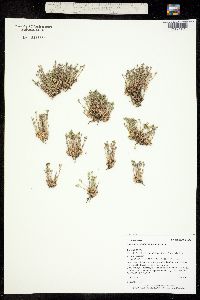Sabulina rubella
|
|
|
|
Family: Caryophyllaceae
beautiful sandwort, more...Boreal Mock Sandwort, boreal stitchwort
[Arenaria propinqua Richards., moreArenaria quadrivalvis , Arenaria rubella (Wahlenb.) Sm., Arenaria rubella var. rubella (Wahlenb.) Sm., Arenaria sulcata Willd. ex D. F. K. Schltdl., Arenaria verna f. epilis Fernald, Arenaria verna var. hirta S. Watson, Arenaria verna var. propinqua (Richards.) Fern., Arenaria verna var. pubescens (Cham. & Schltdl.) Fern., Arenaria verna var. rubella (Wahlenb.) S. Wats., Minuartia rossii var. orthotrichoides auct. non (Schischkin) Hultén, Minuartia rubella (Wahlenb.) Hiern., Minuartia rubella f. epilis (Fernald) J. Cay., Tryphane rubella (Wahlenb.) Reichenb.] |
Flowering summer. Arctic lowlands to rocky ridges and gravelly, montane, calcareous slopes in arctic and alpine tundra, heath and open woods, ± coastal gravelly limestone barrens in the Gulf of St. Lawrence area; 0-3800 m; Greenland; Alta., B.C., Man., Nfld. and Labr., N.W.T., Nunavut, Ont., Que., Sask., Yukon; Alaska, Ariz., Calif., Colo., Idaho, Maine, Mont., Nev., N.Mex., Oreg., S.Dak., Utah, Vt., Wash., Wyo.; arctic Eurasia. Plants perennial, cespitose or mat-forming. Taproots filiform to somewhat thickened; rhizomes absent. Stems ascending to erect, green, 2-8(-18) cm, moderately to densely stipitate-glandular (very rarely glabrous), internodes of stems 1-10 times as long as leaves; trailing stems absent. Leaves overlapping, ± tightly, distally (cauline), concentrated proximally (cauline), connate proximally, with often loose, usually scarious sheath 0.2-0.7 mm; blade ± straight or outwardly curved, green, flat to 3-angled, prominently 3-veined abaxially, subulate, 1.5-10 × 0.3-1.3 mm, flexuous, margins not thickened, scarious, smooth, apex green or purple, acute to apiculate, often navicular, shiny, sparsely to densely ciliate, often stipitate-glandular; axillary leaves present among vegetative leaves. Inflorescences 3-7+-flowered, open cymes or rarely flower solitary, terminal; bracts broadly subulate to narrowly lanceolate, herbaceous, margins scarious. Pedicels 0.2-1.5 cm, densely stipitate-glandular. Flowers: hypanthium disc-shaped; sepals prominently 3-veined, ovate to lanceolate (herbaceous portion oblong to narrowly ovate), 2.5-3.2 mm, not enlarging in fruit, apex green to purple, acute to acuminate, not hooded, stipitate-glandular; petals elliptic, 0.8-1.3 times as long as sepals, apex rounded, entire. Capsules on stipe ca. 0.2 mm, ovoid, 4.5-5 mm, longer than sepals. Seeds reddish brown, suborbiculate with radicle prolonged into beak, somewhat compressed, 0.4-0.5 mm, tuberculate; tubercles low, elongate, rounded (to angled on edge) (50×). 2n = 24. Distinct among the arctic/alpine Minuartia species with its stiff, three-veined leaves, M. rubella is a circumpolar calciphile. We follow Ö. Nilsson (2001) in not recognizing infraspecific taxa that have been described based at least partly on pubescence. Variety propinqua has been applied to glabrous plants, which occur infrequently and sporadically throughout the range of the species. Where they do occur they are often intermixed with sparsely stipitate-glandular plants. This glabrous variety is rarely encountered in western North America.
Short-lived perennial or sometimes annual, compact or loose, 2-10(-15) cm, often decumbent, leafy mostly below the middle, glabrous to glandular-hairy; lvs 5-8 נ0.3-0.8 mm, obtuse or acutish, prominently 3-nerved, puberulent or sometimes glabrous; cymes usually with several fls; pedicels slender, 5-12 mm; sep 3-4.5 mm, lanceolate, acute, strongly 3-nerved; pet usually shorter than the sep; fr membranous, the 3 valves obtuse, entire or slightly emarginate, dehiscing to below the middle; seeds 0.4-0.7 mm, tuberculate; 2n=24, 26. Moist, rocky or gravelly places; circumboreal, s. in Amer. to Que., n. Vt., Ont., and N.M. June-Aug. (Minuartia r.; Sabulina propinqua) Gleason, Henry A. & Cronquist, Arthur J. 1991. Manual of vascular plants of northeastern United States and adjacent Canada. lxxv + 910 pp. ©The New York Botanical Garden. All rights reserved. Used by permission. |

















































































